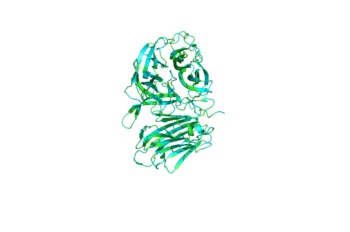Davis L. Martinec/Sandbox 4eqv
From Proteopedia
4EQV - Saccharomyces Invertase
General Description4EQV is 469 kDa invertase(SInv) isolated from Saccharomyces cerevisiae. SInv catalyzes the hydrolysis of sucrose into fructose and glucose, thus making it an essential enzyme to plants and other organisms, such as honey bees[1]. Invertase also lends itself to industry and is extensively used fermentation, where yeast are employed to process sugar into ethanol. Yeast invertase was first isolated in 1860 by Berthelot, but had been alluded to by Dubrunfaut in 1847.[2] Invertase was posited to be an intracellular enzymee, yet de la Fuente and Sols were able to show that invertase can be excreted by the cell, thus it is also extracellular[3]. The intracellular form of the enzyme is not glycosylated, while the extracellular form is extensively glycosylated[1]. The same gene codes for glycosylated and non-glycosylated forms of the enzyme they differ when being transcribed into mRNA, and the extracellular bound SInv is tagged with a signal peptide.[4]
StructureThough it is an octamer, SInv can be best described as a tetramer of dimers[1]. The illustrates this high degree of symmetry. It should also be pointed out that the A/B and C/D dimers have been dubbed "closed" while the E/F and G/H dimers have been dubbed "open"[1]. This idea of "open" and closed" dimers is explained in more detail in the section titled Open & Closed Assembly. Catalytic β-propeller DomainThe of 4EQV, shown in crimson, is the catalytic domain of the monomer. The domain is composed mostly of antiparallel β-strands which form five blades, each containing four antiparallel β-strands. The of the β-propeller domain is formed at the axis of the five blades. This catalytic pocket is contains nucleophilic residue Asp22 at its base and is lined with multiple hydrophobic residues, namely Trp-48, Phe-82, Trp291,Phe296, and Phe388.
β-sandwich Domainthe of invertase A formed by chain A and chain B showing how each active site is capped by the β-sandwich Domain. β-sandwich domains form between residues 343-363. Open & Closed Assemblytest test test testtest test test testtest test test testtest test test testtest test test testtest test test testtest test test testtest test test testtest test test testtest test test testtest test test testtest test test testtest test test testtest test test testtest test test testtest test test testtest test test testtest test test testtest test test testtest test test testtest test test testtest test test testtest test test test
the of chain E
Evolutionary Conservation & Related ProteinsAvailable StructuresThis is a sample scene created with SAT to by Group, and another to make of the protein. You can make your own scenes on SAT starting from scratch or loading and editing one of these sample scenes.
References
| ||||||||||||




